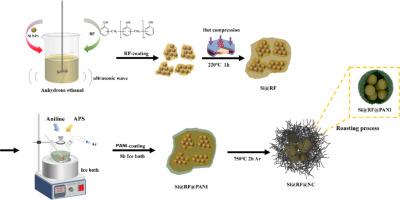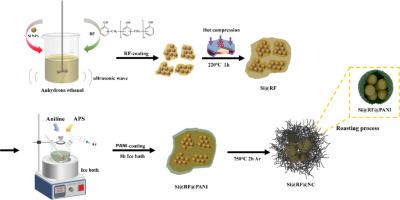Extensively cross-linked conductive dual carbon substrate network for high-performance silicon anode
IF 5.6
3区 材料科学
Q1 ELECTROCHEMISTRY
引用次数: 0
Abstract
Silicon (Si) anodes, with high theoretical capacity, hold great promise for applications in lithium-ion batteries (LIBs). However, it confronts the challenges because of significant volume expansion (∼300 %) and poor electrical conductivity. In this study, we developed a Si based anode material by encapsulating Si nanoparticles within a dual-carbon substrate network to realize the high conductivity and buffering structure for Si. The inner carbon layer is derived from phenolic resin (RF), and possesses rich mesopores that provides buffer space to mitigate the expansion of Si, thereby maintaining the mechanical integrity of anode. Furthermore, the nitrogen-doped carbon (NC) of outer layer derived from conductive polyaniline exhibits high conductivity (1.824 × 10 S·m−1) and highly cross-linked structure, which effectively shortens the Li+ transport path, reducing the energy barrier for Li+ transmission to the Si core. Due to the synergistic protective effect of the inner porous structure and the outer highly cross-linked conductive network, the prepared material (named as Si@RF@NC) shows suppressed volume changes and enhanced electron and ion transport, thus maintaining electrode structural integrity and forming a stable solid electrolyte interphase film. After 100 cycles, the Si@RF@NC anode exhibits a high specific capacity of 762.4 mAh g−1, with a capacity retention rate of 72.8 %, and an electrode expansion rate post-cycling of only 15.56 %. This study provides insights into the design of high-energy LIBs with suppressed expansion in Si anodes.


用于高性能硅阳极的广泛交联导电双碳衬底网络
硅(Si)阳极具有较高的理论容量,在锂离子电池(LIBs)中应用前景广阔。然而,它面临着巨大的体积膨胀(~ 300%)和导电性差的挑战。在这项研究中,我们开发了一种硅基阳极材料,通过将硅纳米颗粒封装在双碳衬底网络中,实现了硅的高导电性和缓冲结构。内碳层由酚醛树脂(RF)制成,具有丰富的中孔,提供缓冲空间以减轻Si的膨胀,从而保持阳极的机械完整性。此外,来自导电聚苯胺的氮掺杂碳(NC)外层具有高导电性(1.824×10 S·m−1)和高度交联结构,有效缩短了Li+的输运路径,降低了Li+传输到Si核的能量垒。由于内部多孔结构和外部高交联导电网络的协同保护作用,制备的材料(命名为Si@RF@NC)的体积变化受到抑制,电子和离子输运增强,从而保持了电极结构的完整性,形成了稳定的固体电解质界面膜。循环100次后,Si@RF@NC阳极的比容量为762.4 mAh g−1,容量保持率为72.8%,循环后的电极膨胀率仅为15.56%。该研究为在Si阳极中抑制膨胀的高能lib的设计提供了见解。
本文章由计算机程序翻译,如有差异,请以英文原文为准。
求助全文
约1分钟内获得全文
求助全文
来源期刊

Electrochimica Acta
工程技术-电化学
CiteScore
11.30
自引率
6.10%
发文量
1634
审稿时长
41 days
期刊介绍:
Electrochimica Acta is an international journal. It is intended for the publication of both original work and reviews in the field of electrochemistry. Electrochemistry should be interpreted to mean any of the research fields covered by the Divisions of the International Society of Electrochemistry listed below, as well as emerging scientific domains covered by ISE New Topics Committee.
 求助内容:
求助内容: 应助结果提醒方式:
应助结果提醒方式:


